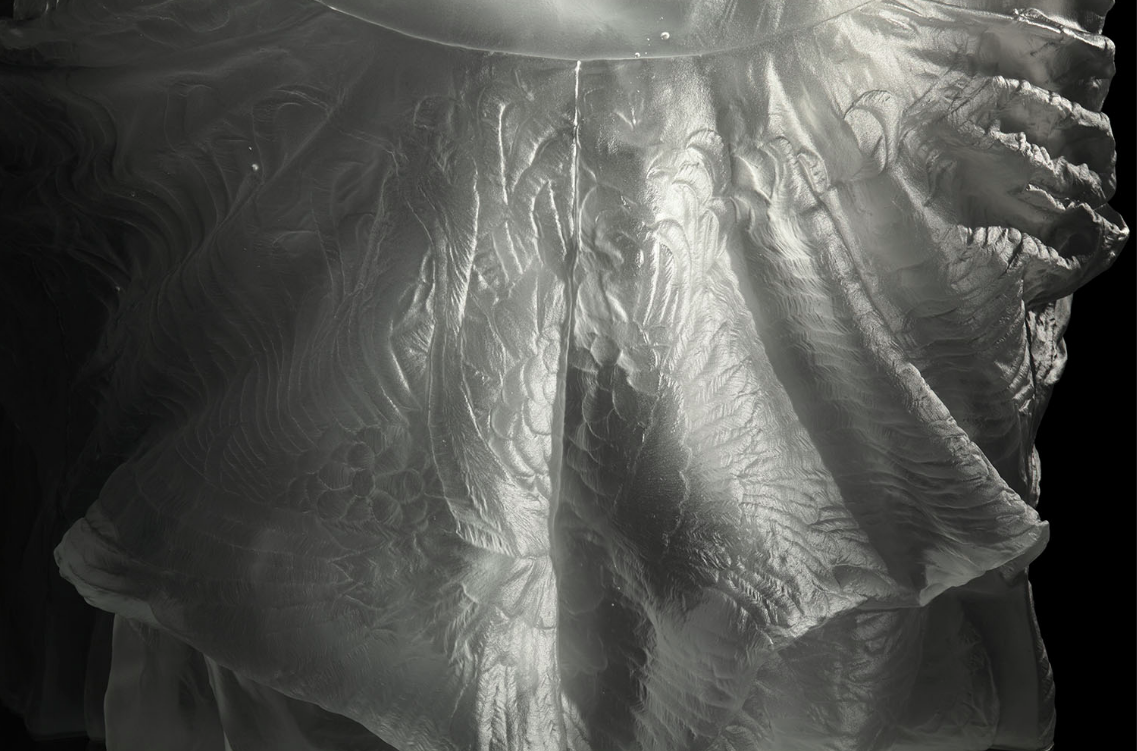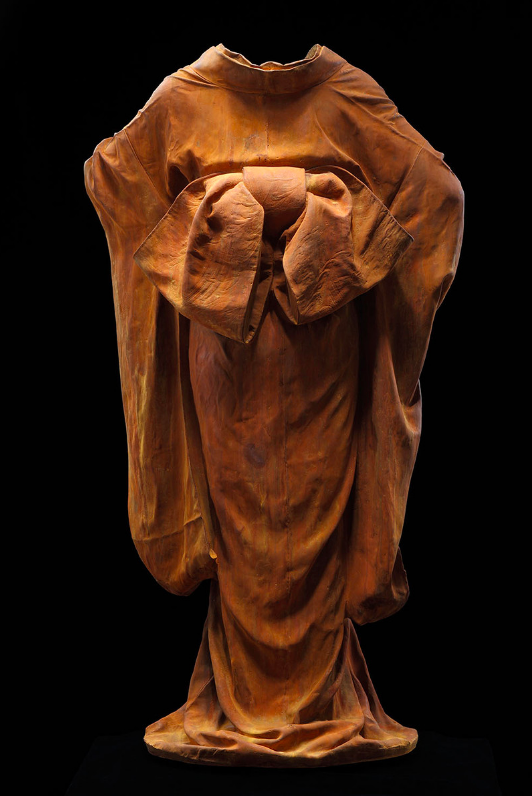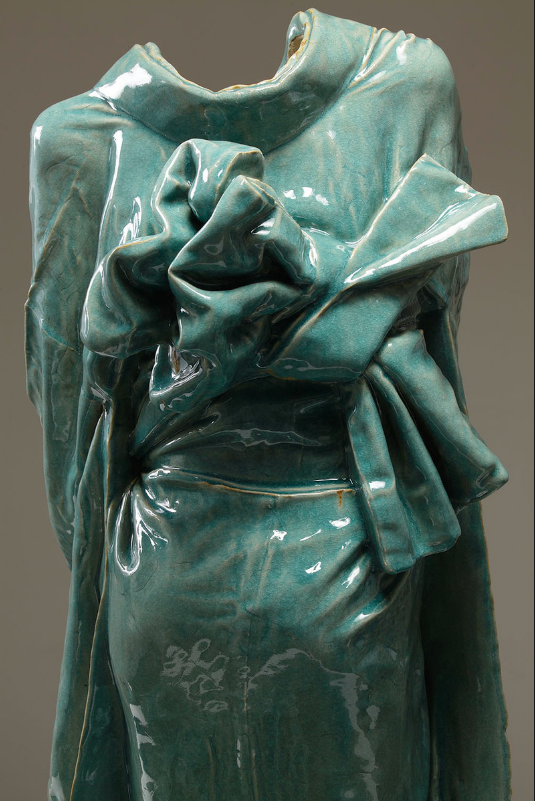Karen LaMonte’s ethereal female figures are absent save for an intimate record of their corporeal presence evoked by the exquisitely detailed drape of clothing. The models who sat for the artist as she created these suggestive forms have left, and what remains is a sculptural rendering of the uncanny, of lingering loss, paradoxes, and strange dualities. LaMonte's dresses thus occupy an intentionally undefined space between presence and absence, tradition and innovation, emptiness and overflowing with meaning. Through September 2nd, 2018, the exhibition "Embodied Beauty" offers 32 of LaMonte's figures to viewers at the Hunter Museum of American Art in Chattanooga, Tennessee. It unites two distinct series of works from her oeuvre, "Nocturnes" and "Floating World," and represents the largest museum exhibition to date of LaMonte’s work in the United States, bringing together her figures in cast glass, clay, bronze, and iron.

The idea of combining the two bodies of work in one show came from the Hunter Museum's chief curator Nandini Makrandi. In a telephone interview with the Glass Quarterly Hot Sheet, LaMonte noted that it was also her own first time seeing the works side by side — an arrangement she found insightful. Sculptures from both were made through a unique lost-wax casting process, and designed on live models and dresses designed by LaMonte herself. As the Hunter frames it: “The female forms in LaMonte’s sculptures, absent, yet implied through the clinging fabric, raise questions about the role that clothing plays in society, and the impact it has on women’s lives, whether in the east or the west.” The latter point is the deviation from LaMonte’s norm here: while much of her career has been devoted to studying the beauty and transience through the motif of clothing, Floating World, the more recent series of the two, is her first direct confrontation of culture.

The body of work, "Nocturnes," represents a more-recent period in LaMonte’s career. The life-sized, spectral figures draw from classical Greek and Roman figures, and were also inspired by the Nocturne musical compositions of John Field and Frederick Chopin as well as the paintings by the same name by James Abbott McNeill Whistler. Glass gowns cast in poses suggestive of the feminine form yet emptied of it, they are intended as “female incarnations of night” in an ode perhaps to the collapse of boundaries in darkness and dreams, as well as to the presence of death in life. “They build on the tradition of the female nude and probe the tension between humanism and eroticism, the physical and the ethereal, the body and the spirit,” LaMonte has written in her artist statement. “The figures are at once intensely physical – muscles and flesh strain against clinging fabric – and yet insubstantial: the figures are absent, implied only by the shapes pressing against the clothing.”
The process of fashioning this paradoxical beauty was typically involved. LaMonte herself sewed the garments to be cast, selecting fabrics for their texture or how they folded and draped, and studying designers from all time periods in her investigation of the “lost art of couture.” Both dressmaker’s mannequins and live models were used to develop her designs in full, lived articulation. "Nocturnes" is also notable for being the project in which LaMonte first used color in glass, working with German scientists to create her desired silvery and ombré blue colors and depths.
Nocturnes thus stands as the culmination of interests in beauty, femininity, the body, and time, and the melding of statuary, fashion, and science.

The earlier body of work in the exhibition, Floating World, revists these themes with an additional focus on culture. This series was developed during LaMonte’s 7-month residency in Kyoto, Japan, on a grant from the Japan-US Friendship commission and the National Endowment for the Arts. Its title is a translation of ukiyo, a culture of pleasure-seeking developed in Edo-period Japan. LaMonte describes it as a “sphere of impermanent, fleeting beauty”, a world “filled with Geisha, Maiko, Kabuki actors, and concubines who floated above the responsibilities of mundane existence in the brothels and teahouses.” Yet ukiyo is a double-edged term, with a homophone that means “Sorrowful World” and “alludes to a language of attraction that tempers beauty with awareness of the body’s transience” – a darkness that lends itself naturally to LaMonte’s practice.
The glass garments of Floating World were formed through LaMonte’s signature casting process, but were also the product of intensive cultural study. On site in the famous textile district Nishijin, she studied all aspects of the traditional dress: weaving fabric, drawing imagery, and studying its ceremonial function, rich codification, and historic meaning. LaMonte spoke to Glass Quarterly of being fascinated by the kimono’s “literal erasure of the body” through the unique method of padding and binding the wearer’s body into an anonymous cylindrical form, thought ideal for displaying the kimono’s imagery. “In eliminating the defining curves of the female body, making it uniform and neutral, the kimono literally erases the self and individuality, transcending the corporeal beauty of its wearer,” LaMonte said. “By putting on the kimono, one is assuming one’s appropriate place in society; its language announces and reproduces that social role.”
From the absent woman, then, LaMonte’s studies had taken her to the woman twice-removed by the kimono’s erasure of her specific form. LaMonte represented this conformity in her own glass interpretation of the kimono by basing her sculptures on a specially formed mannequin whose measurements, compiled from biometric data, are that of the 50th percentile of 40-year-old Japanese women in the year 2000. And in coming to terms with a sensibility she saw as radically different from the European tradition of dress, she turned to the Japanese concept of mu, or nothingness: “an emptiness that contains all, the realm of enlightenment.” LaMonte explained: “Non-individualism is not non-existence; it is embedded existence.”
Finally, LaMonte also spoke of Floating World, which features a wider range of colors and materials than her previous work, as an investigation into the fundamentals of her practice. “I have been thinking about the metaphorical implications of each material – using material as metaphor. I think about the material without form, what it is and what that implies in an essential way,” she said. “I chose clay for humility, glass for spirituality, bronze for human intention, and rust for transience.” Her intriguing point about glass speaks volumes, with LaMonte further citing the tensions between the seen and unseen, the physical and intangible present in the medium as what makes it so eminently suited to her concerns. 
Converging in Embodied Beauty, Nocturnes and Floating World thus represent two fascinating periods and outlooks in LaMonte’s work. Of the installation and display, the artist commented: “The pieces are arranged in two rooms with the Floating World kimonos in one and the Nocturnes in the second, but there is no wall between the rooms so all of the work is in conversation. For the first time, in several incidences, two sculptures in different materials are installed on a single large platform. It makes the relationship between the sculptures much more intimate, and creates a dialogue between materials, inviting connections and comparisons.”
If divided by culture, it may also make sense to see the two series as the lineage of one idea returned to endlessly in different permutations and interpretations.
Certainly, there appears to be a thematic kinship between the nullity of night in Nocturnes and the philosophy of mu in Floating World, both operating on some kind of absence and loss, yet also looking towards what LaMonte calls in her artist statement “the essential and eternal.”

In articulating the philosophy of Floating World, for instance, LaMonte further cites the concepts of mono no aware and wabi-sabi from Japanese philosophy. Mono no aware is the awareness of the “fleetingness of all things that brings a sense of urgency to our appreciation of the present and a beautiful moment or occurrence.” Wabi-sabi is an aesthetic “centered on the acceptance of impermanence” and “derived from the assertion that understanding impermanence is central to enlightenment, and is based on asymmetry, asperity, simplicity, modesty, marks from the passage of time, and a suggestion of natural processes…in short, a profound appreciation of the fragile and fleeting nature of beauty.” These ideas, LaMonte agreed, “relate very well to the meditative nature of the Nocturnes and their connection with nullity and absence, the expansive void like space of night that actually contains everything.”
The result suggests a kind of tranquil memento mori, not negative but rather pleasingly beautiful reminders of transience. As LaMonte said: “Because beauty is ephemeral, it is exquisitely somber – not a celebration of self or individuality, but an acknowledgment of the self’s limits. For me, to represent it is to take comfort in the essential and eternal.”
The essential, the eternal, and the iconic – LaMonte’s work has always seemed to have these concerns at heart, with her interest in the figurative and universally readable. Yet her practice also straddles multiple boundaries, and, as always with artists who work across cultures, there is a need to clarify intention and awareness.

H 39, W 33 1/2, D 32 in.
LaMonte also explained that she had studied Japonisme and recounted: “I have always been fascinated by Japan and Japanese culture, even as a child when one of my best friends was half Japanese and her mother taught us how to make kimonos for all of our dolls.”
LaMonte speaks of her time in Japan with obvious respect, and it has clearly served a more profound and carefully considered purpose than a simple change of aesthetic. The American artist has also been accustomed to working abroad, having relocated to the Czech Republic to study the glass tradition there - although, perhaps tellingly, it has never before risen to the forefront of her work as it has with Embodied Beauty's explicit East and West dichotomy. It remains to be seen whether she will continue to so strongly explore her interest in culture in future works, or whether this means of what LaMonte has described as “re-contextualizing my work" represents merely a divergence from the main path of her art.
In any case, there is a dialogue - with LaMonte's work animated and the kimonos finding a new appreciation in this form - and it is one that should be thoughtfully continued by the viewers of Embodied Beauty.
As for what lies in the future for her art, LaMonte sees her practice taking on two paths. The first is atmosphere, an interest stemming naturally from her meditations for Nocturnes and manifesting in a study of clouds, a motif which has been present in LaMonte’s work since her high school years. The artist has commented: “I am fascinated by their physicality, beauty and dynamic nature. I see clouds in the same category of universal experience as the human figure.” In an intriguing collaboration with Caltech, LaMonte has already produced a cloud sculpture using measurements from a cloud simulation created by a supercomputer, a software program, and a physical robot to assist in carving the marble. The connections to her prior work are lucid and fascinating, with the cloud clearly suggestive of transience and tangibility, and yet also rich in further significance. “My cloud is baroque in its physicality,” LaMonte has said. “It looks like folds of fabric or flesh tumbling through space.”

The second direction her work is taking is towards ideas of gender and biology, which LaMonte plans to develop during her Specialty Glass Residency at Corning. LaMonte’s concern is in “the transformation of our ideas of beauty and what it means to be biological in the 21st century,” and her interpretation is to involve biomimetic glasses and bioglasses in the making of new figurative work. The latter point is a suggestion that though in part a departure from her iconic dresses, LaMonte’s new work may equally be viewed as a continuation of the same style and preoccupations that have ruled her career. Hers is a practice steeped in masterful technique and a readiness towards technology, and above all an eye for the straddling of divides.
The anonymous and inanimate are made intensely intimate and alive; pleasure is tempered with melancholy. Through her phantomic documentation of bodies, her vessels of tender meaning, LaMonte has accomplished what she set out to do: to “anthropomorphize the infinite.” She has commented that her works tend to “focus on atmosphere over narrative”, and whether it also focuses on atmosphere over concept is another unresolved question – along with the real significance of what is prioritized at all – but her work is indisputably powerful, even sublime.
In LaMonte’s wise words, “From beauty, I have become fascinated with the sublime. For me, the heart of the sublime is a sense of longing and desire. Unlike beauty which we can control, the sublime defines a boundary between what we understand and that which lies beyond our power of reason. We are not in control of sublime experiences.”
IF YOU GO:
“Embodied Beauty: Sculptures of Karen LaMonte”
Through September 2nd, 2018
Hunter Museum of American Art
Chattanooga, Tennessee
Tel: 423.267.0968
Website







